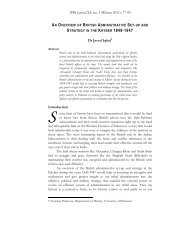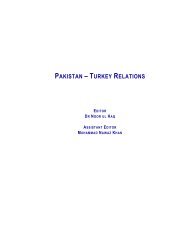120 Whither Kashmir? (Part II) - Islamabad Policy Research Institute
120 Whither Kashmir? (Part II) - Islamabad Policy Research Institute
120 Whither Kashmir? (Part II) - Islamabad Policy Research Institute
Create successful ePaper yourself
Turn your PDF publications into a flip-book with our unique Google optimized e-Paper software.
42 IPRI Factfile<br />
Princely states, over five hundred joined India, but none was accorded<br />
this special status.<br />
Through this status and a number of commitments, India kept<br />
luring in <strong>Kashmir</strong>i masses to become its part. Upon failure of winning<br />
their commiserations, India forced its way, through a fake assembly<br />
resolution in mid 1950s and thereafter started calling the state as its<br />
integral part. United Nations, however, through its resolution, No.2017<br />
of 30 March 1951 and S.3779 of January 24, 1957, made it absolutely clear<br />
that; any action which <strong>Kashmir</strong> Constituent Assembly may have taken or<br />
might attempt to take to determine the future shape of state or any of its<br />
part would not constitute the disposition of the state and that election of<br />
State’s Constituent Assembly cannot be a substitute for plebiscite. Thus,<br />
this act of India was a blatant violation of the UNSC resolutions that<br />
India had accepted too.<br />
Inaccuracy of Indian claim of accession can be judged from the<br />
top-secret letter addressed to British Government by Mr Alexander<br />
Symon, UK High Commissioner to India. In this letter, he briefly<br />
described the events until 4.00 P.M on [27] October 1947, as; ten Indian<br />
aircrafts loaded with arms and troops were dispatched to <strong>Kashmir</strong> from<br />
New Delhi on the morning of 27 October 1947. Until 4 P.M of 27<br />
October 1947, Mr V.P. Menon has not reported from Jammu, which<br />
mean accession documents were either not signed or signed by Hari Singh<br />
on 27 October 1947, and there were only rumours of <strong>Kashmir</strong> accession<br />
to Indian Union without any confirmation.<br />
Indian antagonistic approach can be imagined from the fact that<br />
<strong>Kashmir</strong>i Administration had requested for a Standstill Agreement with<br />
both India and Pakistan. Pakistan, however, accepted this offer but India<br />
owing to its pre-planned evil designs did not accept it. Instead of<br />
accepting it, India started interference in state’s affair through leaders like<br />
Sheikh Abdullah. Finally, they paved the way for illegal interference in<br />
the state’s affair through military invasion by her forces in October 1947.<br />
From July to October 1947, with the connivance of Indian leaders<br />
like Pandit Jawaharlal Nehru, Patel, and V.P Menon, three <strong>Kashmir</strong>i<br />
Prime Ministers were changed one after the other. Pandit Kak, the State’s<br />
Prime Minister, was indeed favouring state’s accession to Pakistan or to<br />
keep it independent. He was a strong opponent of states accession to<br />
India, in spite of being a Hindu Pandit. Mahajan, who replaced Pandit<br />
Kak as new Prime Minister was a non-<strong>Kashmir</strong>i. He was a Judge of East<br />
Punjab High Court and has been the member of Radcliff Award, and




